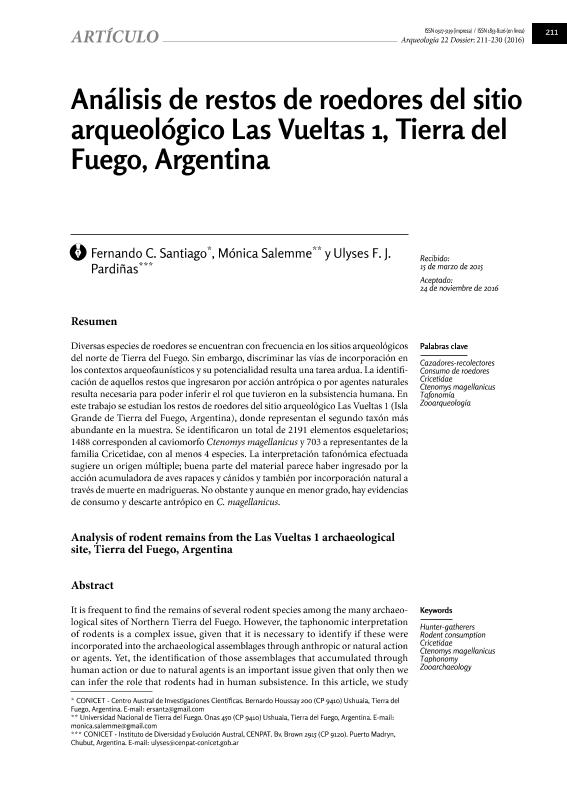Mostrar el registro sencillo del ítem
dc.contributor.author
Santiago, Fernando Carlos

dc.contributor.author
Salemme, Monica Cira

dc.contributor.author
Pardiñas, Ulises Francisco J.

dc.date.available
2018-02-16T20:21:55Z
dc.date.issued
2016
dc.identifier.citation
Santiago, Fernando Carlos; Salemme, Monica Cira; Pardiñas, Ulises Francisco J.; Análisis de restos de roedores del sitio arqueológico Las Vueltas 1, Tierra del Fuego, Argentina; Universidad de Buenos Aires. Facultad de Filosofía y Letras; Arqueología (Buenos Aires); 22; 2016; 211-230
dc.identifier.issn
0327-5159
dc.identifier.uri
http://hdl.handle.net/11336/36668
dc.description.abstract
Diversas especies de roedores se encuentran con frecuencia en los sitios arqueológicos del norte de Tierra del Fuego. Sin embargo, discriminar las vías de incorporación en los contextos arqueofaunísticos y su potencialidad resulta una tarea ardua. La identificación de aquellos restos que ingresaron por acción antrópica o por agentes naturales resulta necesaria para poder inferir el rol que tuvieron en la subsistencia humana. En este trabajo se estudian los restos de roedores del sitio arqueológico Las Vueltas 1 (Isla Grande de Tierra del Fuego, Argentina), donde representan el segundo taxón más abundante en la muestra. Se identificaron un total de 2191 elementos esqueletarios; 1488 corresponden al caviomorfo Ctenomys magellanicus y 703 a representantes de la familia Cricetidae, con al menos 4 especies. La interpretación tafonómica efectuada sugiere un origen múltiple; buena parte del material parece haber ingresado por la acción acumuladora de aves rapaces y cánidos y también por incorporación natural a través de muerte en madrigueras. No obstante y aunque en menor grado, hay evidencias de consumo y descarte antrópico en C. magellanicus.
dc.description.abstract
It is frequent to find the remains of several rodent species among the many archaeological sites of Northern Tierra del Fuego. However, the taphonomic interpretation of rodents is a complex issue, given that it is necessary to identify if these were incorporated into the archaeological assemblages through anthropic or natural action or agents. Yet, the identification of those assemblages that accumulated through human action or due to natural agents is an important issue given that only then we can infer the role that rodents had in human subsistence. In this article, we study rodent remains recovered from the archaeological site of Las Vueltas 1 (Isla Grande de Tierra del Fuego, Argentina); here rodents represented the second most common taxon present in the assemblage. A total of 2191 skeletal elements were recorded; 1488 remains belonged to the caviomorph, Ctenomys magellanicus, while 703 specimens belonged to at least four Cricetidae species. From a taphonomic perspective, a large number of the remains would have entered the archaeological assemblage through actions by raptors, carnivores, and as a result of natural death in burrows. Nevertheless, although to a lesser extent, there is also evidence of human consump- tion and discard of C. magellanicus.
dc.format
application/pdf
dc.language.iso
spa
dc.publisher
Universidad de Buenos Aires. Facultad de Filosofía y Letras

dc.rights
info:eu-repo/semantics/openAccess
dc.rights.uri
https://creativecommons.org/licenses/by-nc-sa/2.5/ar/
dc.subject
Cazadores-Recolectores
dc.subject
Consumo de Roedores
dc.subject
Cricetidae
dc.subject
Ctenomys Magellanicus
dc.subject
Tafonomía
dc.subject
Zooarqueología
dc.subject
Hunter-Gatherers
dc.subject
Rodent Consumption
dc.subject
Cricetidae
dc.subject
Ctenomys Magellanicus
dc.subject
Taphonomy
dc.subject
Zooarchaeology
dc.subject.classification
Historia

dc.subject.classification
Historia y Arqueología

dc.subject.classification
HUMANIDADES

dc.title
Análisis de restos de roedores del sitio arqueológico Las Vueltas 1, Tierra del Fuego, Argentina
dc.title
Analysis of rodent remains from the Las Vueltas 1 archaeological site, Tierra del Fuego, Argentina
dc.type
info:eu-repo/semantics/article
dc.type
info:ar-repo/semantics/artículo
dc.type
info:eu-repo/semantics/publishedVersion
dc.date.updated
2018-02-15T16:55:57Z
dc.identifier.eissn
1853-8126
dc.journal.volume
22
dc.journal.pagination
211-230
dc.journal.pais
Argentina

dc.journal.ciudad
Ciudad Autónoma de Buenos Aires
dc.description.fil
Fil: Santiago, Fernando Carlos. Consejo Nacional de Investigaciones Científicas y Técnicas. Centro Austral de Investigaciones Científicas; Argentina
dc.description.fil
Fil: Salemme, Monica Cira. Universidad Nacional de Tierra del Fuego; Argentina. Consejo Nacional de Investigaciones Científicas y Técnicas; Argentina
dc.description.fil
Fil: Pardiñas, Ulises Francisco J.. Consejo Nacional de Investigaciones Científicas y Técnicas. Centro Científico Tecnológico Conicet - Centro Nacional Patagónico. Instituto de Diversidad y Evolución Austral; Argentina
dc.journal.title
Arqueología (Buenos Aires)

dc.relation.alternativeid
info:eu-repo/semantics/altIdentifier/url/http://revistascientificas.filo.uba.ar/index.php/Arqueologia/article/view/3284
Archivos asociados
